Canon Q&A @ CP+ 2015: Autofocus, whither full-frame mirrorless, and can 5Ds video best the 5D III?
posted Monday, February 16, 2015 at 6:03 PM EST

I always enjoy the opportunity to meet with camera and lens company executives, and dig a little deeper into some of the behind-the-scenes information and tech details about their products. (I admit it, I'm a pretty serious camera-tech geek :-)
Here's the content of my first executive interview from the CP+ 2015 show in Yokohama, Japan a few days ago. On hand to answer my questions were Yasuhiko Shiomi (Senior General Manager, ICP Development Center 2), Yoshiyuki Mizoguchi (Group Executive, ICP Group 3) and Naoya Kaneda (Senior General Manager, ICP Development Center 1), all from the Image Communication Products Operations division at Canon Inc. Adeptly handling translation between English and Japanese was Richard Berger (Manager, Global PR), also from Canon Inc.
Many thanks to everyone at Canon for making time to meet with me!
Dave Etchells/Imaging Resource: My first question is on autofocus technology: The most recent generation of Hybrid CMOS AF is much faster than the previous one. Can you tell us what technical advances led to that improvement? Also, how would you compare the new Hybrid CMOS AF III's performance to that of Dual Pixel CMOS AF, in terms of speed and accuracy?
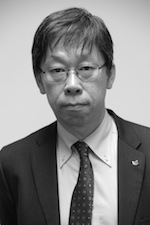
Senior General Manager
ICP Development
Center 2
Image Communication Products Operations
Canon Inc.
Yasuhiko Shiomi/Canon Inc.: Compared with conventional models, first of all the number of pixels has increased significantly, and the pixel density has also increased. So we've incorporated Hybrid CMOS AF across the board with all of the models [that don't already use Dual Pixel CMOS AF]. We've also improved the algorithms used to calculate AF, which has improved speed. However, with regard to Dual Pixel CMOS AF, the conditions that are required for applying this technology are different. It's not really an apples to apples comparison.
DE: You can't really compare them.
YS: There are a lot of conditions involved, such as the shooting scene and the lenses that are used. So depending on these factors, you're going to get different results. However, compared with the earlier versions of Hybrid CMOS AF, we have realized an improvement of three to four times faster AF speed.
DE: So what specifically has allowed that increase in speed? Is it the chip readout, or processing, or both? It's such a dramatic change. It seems like there's some kind of a revolutionary or very significant technology development involved.
YS: With previous versions of Hybrid CMOS AF, it made use of both phase-difference AF and contrast AF. With the current generation of Hybrid CMOS AF III, it leans more toward phase-difference AF, and it makes very little use of contrast AF method.
DE: So most of the time, if there's enough light or something… Is its choice of phase-detect or contrast-detect dependent on how much light there is? I mean, if it's bright enough, is it only phase-detect? Or is it always phase-detect, with just a little bit of contrast at the end?
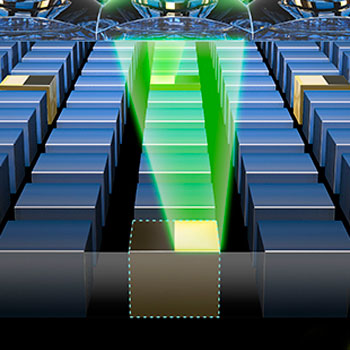
YS: Brightness is a factor. However, another factor is the difference in contrast between the center of the imaging area and the surrounding peripheral areas of the imaging area. So when focusing on something that is located in the center of the imaging area, it gets much easier for phase-difference AF to acknowledge that. The farther you get away from the center of the imaging area, it becomes more difficult to establish proper focus with phase-difference AF.
DE: Oh yeah. You're not getting the whole light cone, just part.
YS: Yes. Also, in dark shooting environments, it's easier for contrast AF to handle focusing responsibilities.
DE: Ah, very good answers, thanks. Do you think there’ll always be a separation in performance between on-chip hybrid or dual-pixel AF and SLRs with dedicated AF sensors? Will SLRs always win out? If not, at what point do you think there’ll be parity between the two technologies in terms of performance?
YS: When it comes to still photography with super-telephoto lenses that pros will make use of, I think it's safe to say that SLRs will win out. However, that difference is going to be reduced when we talk about entry-level models that don't have a dedicated AF sensor. That gap is closing. But as far as covering a wide range of shooting situations and super-telephoto lenses, while the other approach is kind of closing the gap, I think it'll probably be a while before they actually line up, or one takes over the other. It will be hard to predict if and when that will happen. So for a while, the advantage, I think, will rest with the separate sensor. [as in DSLRs]
DE: So they actually could catch up someday, but… it sounds like maybe not really?
YS: That's right… [laughter]
DE: It sounds like there's a fundamental advantage in the separate sensor.

YS: You're right. With EOS AF, the camera can establish focus even when the scene is extremely out of focus. So there's the first-stage image formation, second-stage image formation.
DE: Right.
YS: ...and the EOS AF, because of its dedicated nature, can handle that.
DE: Ah, it can handle extreme out of focus, whereas on-chip has a hard time with that?
YS: There's a shift, it falls out of alignment.
DE: Oh, I see: In the EOS AF, are there separate optics so that one set of optics will be able to see if it's far-focus?
YS: Yes.
DE: Ah, okay. So there are some optics, say if it's way out of focus too far, one set of optics can recognize that, and another set can say, 'Oh, it's way out of focus too close.' And then once it gets in range…
YS: It's not quite exactly like that, but it's the focusing lens group is what's moving within the lens. If the image is too extremely out of focus, then it doesn't generate an AF signal.
DE: Yeah.
YS: So when it gets within the focal range, the proper focal range, then there's an AF signal that it can acknowledge and handle.
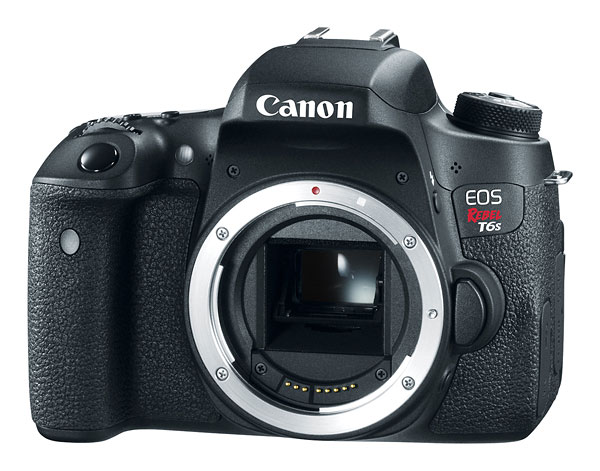
DE: Got it, thanks. ...I just realized I need to move more quickly through the questions. I asked two questions, and I have only 25 minutes left. [laughter]
So, let me move to the new EOS models, the Rebel T6s and T6i. They both have low-pass filters in them, which we actually think is a good idea. But there's a general move away from low-pass filters in recent years. Consumers seem to be favoring designs with no low-pass filter. Does Canon feel the pressure to explain to the consumer why you've got low-pass filters, and how do you answer that question?
YS: With our EOS lineup of cameras, first of all we assume, we are working from the basis that they will be used with high-performance lenses, with high resolving power. If you're going to be using lenses that don't offer that level of resolution, perhaps you can get away without a low-pass filter. However, based on the assumption that our users will be using high-performance, high-resolution lenses, we feel it's essential that the cameras have the low-pass filters.
DE: Yes. For some manufacturers, the lens is effectively the low-pass filter, right?
YS: [lots of laughter] The lenses run the gamut. There's high-end and there's more... shall we say -- cost-competitive.
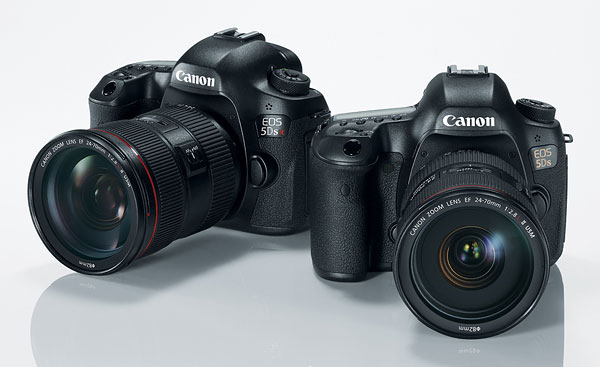
DE: Okay. Switching to the EOS 5DS and 5DS R, the EOS 5D Mark III is the best SLR we've ever seen when it comes to avoiding moiré in video. Will the new full-frame 5DS and 5DS R have the same pixel re-sampling technology as the 5D III, or are there just too many pixels to cope with to do that, even with dual DIGIC 6 processors?
YS: The method is a little bit different. Essentially, as you know, the pixel count is higher in the cameras [than in the video stream]. So for that reason we wanted to improve the resolving performance in the videos that these cameras are capable of taking. For that reason, we went with a method that was more appropriate for those needs. So with 5D Mark III, in terms of resolving power resolution, it's not quite where we wanted it to be, or where we thought it should be. So to kind of resolve that issue, we took steps to address that in the new cameras.
DE: Ah, right. And so for video resolution, the 5D III is very good at anti-aliasing and no moiré, but you felt it could be sharper.
YS: Yeah. We were confident that the moiré would be suppressed. However, we felt the clarity, or the resolution maybe wasn't where it could have been.
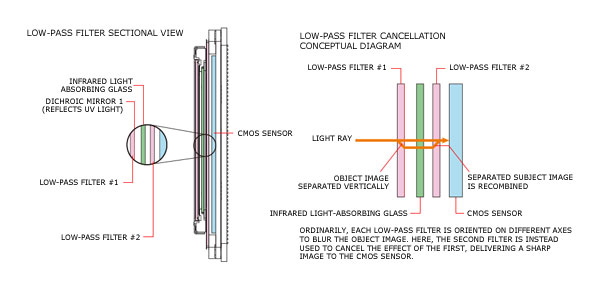
(Diagram courtesy of Canon; translation by Imaging Resource.)
DE: So the new one…
YS: There's a Japanese expression that translates as "sleepy": The image was maybe a little on the sleepy side. So you might be sleepy because you just traveled in from the USA…
DE: Yeah, different sleepy. I do feel sort of fuzzy, you know, but… [laughter] Okay, good. So the 5DS, it shouldn't have moiré but it should be sharper.
YS: Yes, there is an increase in resolution.
DE: Switching to mirrorless: Where do mirrorless systems fit into Canon's longer-term strategy? Does Canon view mirrorless as primary or exclusively a sub-frame platform? Or do you see it as being more broadly applicable, and appropriate for both sub-frame and full-frame systems? And then the second half of the question is will we see the EOS M line evolve further, or will there be a completely new platform at some point?
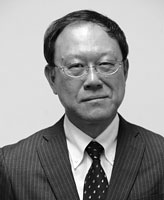
Group Executive
ICP Group 3
Image Communication Products Division
Canon Inc.
Yoshiyuki Mizoguchi/Canon Inc.: Okay. In terms of how we view the role of mirrorless, first it's within the EOS framework that we're talking about. There was obviously the need to pursue smaller products that were more lightweight. So we kind of view the EOS mirrorless cameras from that perspective to begin with. It's not just looking in terms of solely as a mirrorless product, but within the interchangeable lens camera segment. We kind of view it as playing a role within that ... sort of an extended view, as a means of achieving a more compact, lightweight product. There was obviously the question of whether or not, within the regular DSLR format, there was a demand for lighter, smaller products. You know, there are various approaches on that, but this is a means for us to address that issue within sort of the EOS universe.
DE: Right. So you see it as being a case of... That's how you get compact. If someone's willing to accept larger size, then you go for the existing...
YM: With regard to 35mm full-frame cameras, we're looking at the advanced amateur user segment, and demand for that level of performance is high among those. But then you begin to say, what features can you do away with [to reduce the size]? Like say, an optical viewfinder or EOS AF. It becomes sort of a search to see where demand falls, and to what degree users are willing to do without certain features [for a smaller camera]. Then there's the APS-C size frame [where users may accept different trade-offs]. So it depends if users are willing to accept a degradation of image quality [to achieve a smaller size], and where the demand falls. [That is, to what extent are consumers willing to give up some image quality in exchange for a smaller sensor, to have a smaller camera?] So it was through that means for us to respond to the demand within this sort of step-ladder of different users.
DE: Oh, I see.
YM: I can't go into detail, obviously, about our future plans. But our aim, if the demand is there, is to boost imaging performance while maintaining a compact, lightweight design, to satisfy even higher-end users, or to create demand at a higher level within the same sort of compact format.
DE: Right. So it'll depend somewhat on the market.
YM: So if there's no demand, then it doesn't make sense for us to…
DE: Obviously, right.
YM: So it will depend on whether the demand is there, we will do our best to meet it.
[Ed. Note: My conclusion from all this is that, while Canon would never say "never" to a full-frame mirrorless body/lens system, their current thinking is that "compact" and "full-frame" really don't belong in the same sentence together. Who knows what the distant future might bring, but for now, I won't be holding my breath waiting for a full-frame mirrorless system from Canon any time soon.]
DE: So a question on lenses now. This is more just about your organization. You obviously have an enormous investment in lens development. I was curious, and I thought our readers might be too: How large is the division which does lenses? Are you able to tell us how many people you have working on lenses?
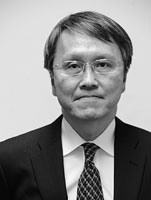
Senior General Manager,
ICP Development Center 1, Image Communications Products Operations, Canon Inc.
Naoya Kaneda/Canon Inc.: That's top secret! [laughter]
DE: Okay. Maybe you can tell me, has that division grown in the last five years?
NK: It's of the highest priority that we boost and strengthen our lens line up. We're doing our best to put out high-quality lenses to meet market demand. So while we can't go into specific details, we are boosting, in various respects, our ability to do that. That includes our R&D environment. So it wouldn't necessarily be limited to just increasing numbers of people working there. Unfortunately we can't go into details, but we're doing everything that is required for us to boost our optical performance.
DE: The people, the tools, the manufacturing, yes.
Another lens question, this has to do with IS. When we tested the new 400 mm DO II lens, we found the stabilization system to be extremely good. We were even able to get a small number of handheld shots as slow as 1/8th of a second. We were just amazed; we'd never seen anything like that before. In another briefing, we heard that part of why the IS is so good is that apparently it has to do with a low-friction, ceramic ball-bearing mechanism for smoother operation. Is that in fact a significant part of why the IS is better? And if it is, is that technology able to come down to smaller, less expensive lenses?
NK: That's not the reason for the improved performance: This isn't the first time that the ceramic ball system has been deployed.
DE: Oh, really?
NK: Yeah. It's not really thanks to the ceramic ball-bearing system that performance is where it is. It's multiple factors; there are improved algorithms, it's the system design overall, and also just basically the day to day hard work and effort to improve performance [over time].
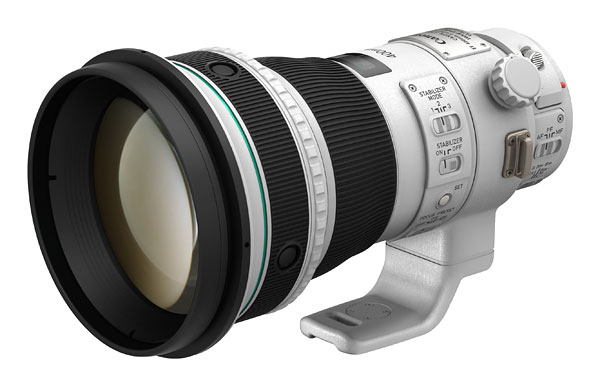
DE: Yeah. I think there has been a significant advance in the gyro sensors in recent years, though right?
NK: Over the past few years there have definitely been improvements in the gyro sensors, but that's not something that significantly comes to play with this particular model.
DE: Oh, really? So it's not so much a change in sensor performance, but other aspects.
NK: The gyro sensor used here isn't an all-new gyro sensor.
DE: Ah...
NK: It's been used in previous lenses. If you really have to kind of pick something, probably it would be leaning more toward the algorithms.
DE: The algorithms, ah. Yes, very interesting! I am almost out of time. Maybe I can do one more question. I think I'd prepared maybe five hours of questions though! [laughter]
[Ed. Note: This was particularly interesting to me. There have, in fact, been some significant improvements in gyro sensors in the last several years, and other manufacturers have pointed to that as a significant part of advances in IS performance. I do know, though, that there's another class of micromechanical gyro sensors with considerably higher performance that has been available for quite a while now. To my knowledge, they haven't been used for lens or camera IS systems previously, simply because they cost too much. Given the selling price of the 400mm (and possibly other lenses using the same sensor), though, maybe Canon was able to afford that much higher-performance technology? Whatever the case, IS performance on the EF 400mm f/4 DO IS II USM lens is pretty downright amazing. If you can ever get your hands on one to play with at a trade show or camera store, I expect you'll be as amazed as we were.]

DE: Perhaps another question about mirrorless cameras and the EOS M-series, specifically the EOS M3. The EOS M series in its third generation now, but only the original came to the US. In our view, its main issue or problem was slow AF, but now you have the new, much faster Hybrid AF available. Do you think that will overcome resistance in the US?
NK: In terms of AF performance compared with the original EOS M and M2, we believe that we've realized a significant improvement in AF performance with the M3. Now the question is, will that satisfy all users in terms of performance? That's something that remains to be seen. Looking at the various markets, we see quite a variation in which markets are embracing mirrorless cameras and which aren't. At the moment we don't really see very strong demand in the US market. We've discussed it with our national sales organizations, and it's in discussion with them to decide whether or not to launch them in the various regions. Either way, through our EOS-series and the EOS M-series, we will do our best to satisfy the demand that is there in terms of smaller and lighter-weight cameras.
DE: OK, I'm really more than out of time now, need to hurry to my next appointment. Arigatou gozaimasu, thank you very much to all of you for making time in your very busy schedules to meet with me!